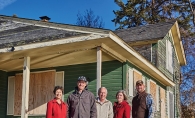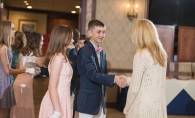ONLINE HED: Hilltop Primary School Engages Students with Environmental Education
HED: Reading, Writing and Planting Trees
DEK: Hilltop Primary School incorporates environmental education into its curriculum.
BY: Madie Scott
Hilltop Primary School (K-4) has found a new way to get kids off their electronics and back outdoors. With the help of the local watershed district and Three Rivers Park District, Hilltop is creating an impressive environmental education curriculum. Using property near the school on Dutch Lake, kids are able to gain hands-on experience and gain real-world skills.
About four years ago, classes began to explore the Dutch Lake property on field trips a few times per school year. The property on Dutch Lake has a mix of maple forests and waterfront property, wetlands, and even a yard where a home once stood, says Mike Wallace, physical education teacher at Hilltop and liaison for the environmental program.
As these field trips were successful, Three Rivers sent Brett Sieberer, a naturalist at the Lowry Nature Center, to assist with environmental teaching. He has continued to work with Hilltop, and in the 2013-14 school year, he visited the school every Friday to teach environmental education. Lessons are on topics like life cycles, camouflage, the water cycle and other things that just can’t really be done as well in the classroom. “When you get outside and you’re doing it, it really catches kids,” says Wallace. “It’s way different.”
Hilltop is now using the environmental education program as a catalyst for captivating students’ interest in learning. The program has expanded from part of the science curriculum; now, kids use their findings and data to help with writing exercises, math problems and art.
Hilltop also has a weather station where kids can pull historical and current data and learn about geography and wind speeds. Students can even use the real-life graphing of rainfall and temperatures as data points to practice their graphing in math, so they integrate what they learn outside into the classroom—often without even knowing it.
The curriculum is also teaching students skills they wouldn’t learn from a book. For example, four years ago, when the program was starting up, Hilltop got a grant from the Tree Trust and each classroom (20 at the time) got to plant its own maple tree; in 2014, the students and faculty used one to collect sap. There was enough for every kid in the school to taste some of the syrup that was made from the very trees they planted a few years earlier. One of the grade levels even named the tree Old Sappy.
“My son was a kindergartner when they planted the trees,” says Wallace. “He’s in fourth grade now and he knows which tree is his … That tree will be there when he graduates.”
Why teach the kids environmental education? “To make learning authentic,” says Wallace. At Hilltop, learning isn’t just about a story problem in a math book. Kids are going outside, measuring things and making their own math problems—or writing stories in English about a beloved tree named Old Sappy.
Hilltop Primary School (K-4) has found a new way to get kids off their electronics and back outdoors. With the help of the local watershed district and Three Rivers Park District, Hilltop is creating an impressive environmental education curriculum. Using property near the school on Dutch Lake, kids are able to gain hands-on experience and gain real-world skills.
About four years ago, classes began to explore the Dutch Lake property on field trips a few times per school year. The property on Dutch Lake has a mix of maple forests and waterfront property, wetlands, and even a yard where a home once stood, says Mike Wallace, physical education teacher at Hilltop and liaison for the environmental program.
As these field trips were successful, Three Rivers sent Brett Sieberer, a naturalist at the Lowry Nature Center, to assist with environmental teaching. He has continued to work with Hilltop, and in the 2013-14 school year, he visited the school every Friday to teach environmental education. Lessons are on topics like life cycles, camouflage, the water cycle and other things that just can’t really be done as well in the classroom.
“When you get outside and you’re doing it, it really catches kids,” says Wallace. “It’s way different.”
Hilltop is now using the environmental education program as a catalyst for captivating students’ interest in learning. The program has expanded from part of the science curriculum; now, kids use their findings and data to help with writing exercises, math problems and art.
Hilltop also has a weather station where kids can pull historical and current data and learn about geography and wind speeds. Students can even use the real-life graphing of rainfall and temperatures as data points to practice their graphing in math, so they integrate what they learn outside into the classroom—often without even knowing it.
The curriculum is also teaching students skills they wouldn’t learn from a book. For example, four years ago, when the program was starting up, Hilltop got a grant from the Tree Trust and each classroom (20 at the time) got to plant its own maple tree; in 2014, the students and faculty used one to collect sap. There was enough for every kid in the school to taste some of the syrup that was made from the very trees they planted a few years earlier. One of the grade levels even named the tree Old Sappy.
“My son was a kindergartner when they planted the trees,” says Wallace. “He’s in fourth grade now and he knows which tree is his … That tree will be there when he graduates.”
Why teach the kids environmental education?
“To make learning authentic,” says Wallace. At Hilltop, learning isn’t just about a story problem in a math book. Kids are going outside, measuring things and making their own math problems—or writing stories in English about a beloved tree named Old Sappy.









